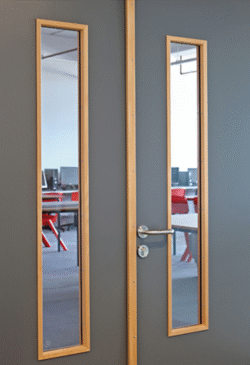Acoustic Doorsets for sound-sensitive spaces
Excessive noise does more than create frustration. In schools, hospitals and residential buildings, it can affect wellbeing, privacy and recovery. Despite this, acoustic doorset performance is still often an afterthought during specification. By understanding acoustic performance early, specifiers can create buildings that are more comfortable, compliant and fit for purpose.
In this article:
• What acoustic ratings mean and how they are tested
• When to combine acoustic and fire performance
• Design choices that affect sound control
• How Lloyd Worrall’s Interspec Doorsets meet multiple standards
When specifying doorsets, most are aware of the importance of fire ratings, smoke seals, structural strength, durability, and aesthetics. But acoustic performance is often considered much later in the process or missed entirely. Noise intrusion or leakage can be a serious issue, undermining how a building feels and functions. This particularly applies to hospitals, classrooms or flats.
With awareness about the links between acoustics and well-being, privacy, productivity and comfort growing, acoustic ratings are becoming an essential criteria in doorset specification. The goal is to shift acoustic performance from a nice bonus to an essential feature in sound-sensitive spaces. In this blog post we aim to explain the meaning of acoustic ratings, where acoustics and fire performance overlap, and how design choices influence performance.
What acoustic ratings really mean
Acoustic ratings indicate how much sound is reduced by passing through a door. This rating is decided by testing standards, such as EN ISO 140-3, where the doorset is tested as a complete unit. Frames, seals and quality of installation all matter, as the acoustic rating doesn’t come from the door leaf alone.
The actual acoustic rating of a doorset is often calculated relative to the wall, as the wall’s rating is often higher, so the doorset rating must be calculated appropriately. Achieving a higher acoustic performance usually requires thicker door leaves, better seals and heavier cores, which must all be considered in the specification process. This means that adding acoustic performance can affect weight, costs, ironmongery loading and, in some cases, even fire rating.
Why noise control matters

Uncontrolled noise can have a significant impact in many environments, such as education, healthcare and residential developments.
In classrooms, study rooms and corridors, poor acoustics can lead to distraction, reduced concentration, increased stress and difficulty communicating. This affects both students and teachers, disrupting lessons, exams and everyday activities.
Healthcare environments face more severe problems as patient recovery, confidentiality and restful environments are all affected by noise. Blocking out the inevitable noise from a busy hospital environment is vital for patient well-being and healing.
In residential buildings, particularly flats and co-living developments, noise between households can seriously impact quality of life, privacy and tenant satisfaction. Mechanical sounds, conversations and corridor noise can all reduce comfort in high-end developments.
With awareness of acoustic performance growing, building standards are pushing for improved acoustic ratings, especially in new developments. The psychological and physical links between quieter environments, reduced stress and higher satisfaction are well known, so it is important that this is reflected in construction and specification.
Where acoustic rated doorsets are needed
While it would be beneficial for all doors to have higher acoustic ratings, this is not always practical. However, there are several spaces within each sector where performance should be prioritised.
• Healthcare – consultation rooms, ward rooms, therapy suites, imaging rooms, nursing stations, or all areas where privacy, rest and sound control are critical.
• Education – Science labs, music rooms, lecture halls, meeting rooms, and libraries benefit most from sound control.
• Residential – between flats and corridor walls, where noise transmission is a concern for tenants.
• Commercial / hospitality – to prevent noise bleed into guest rooms, public areas, larger offices, kitchen spaces or meeting rooms.
Many of these spaces require both acoustic and fire performance, such as corridors and shared areas. In these cases, the specification must balance both requirements using door leaves, seals, cores, glazing and hardware that are compliant in both.
When to combine acoustic and fire performance

Most projects require fire rated doorsets for regulatory safety, but certain spaces demand both fire and acoustic ratings. Thiscan create challenges if not managed early in the specification process.
To meet acoustic ratings, doorsets may need thicker leaves which must still comply with fire test limits. Seals must perform under both fire and acoustic conditions, so choosing between intumescent, smoke and acoustic seals is critical. Hardware such as hinges, closers and locks must be compatible with both fire and acoustic performance, as mismatched components can reduce effectiveness.
It is good practice to set performance targets early so the door can be designed to satisfy both requirements. Our Interspec Doorset range offers options that meet fire, smoke and acoustic standards, ensuring compliance and performance where needed. All products in this range conform to the latest British Standards, European Standards and current Building Regulations.
Design choices that affect acoustic performance
Seals
Drop seals, acoustic threshold seals and perimeter seals are essential. Any gap will undermine performance. On leaves and meeting stiles, seals must be correctly positioned and securely fitted.
Door core, thickness and material
Heavier or denser cores help reduce sound transmission. Lloyd Worrall uses a flaxboard core with timber stiles and rails, covered with veneered, laminated or fully painted facings. Thicker leaves may be required to meet acoustic targets, which affects frame size, hinge loading and overall weight.
Glazing and vision panels
Where vision panels are included, glazing must be rated for both fire and acoustic performance. The frame and seals around the glazing must be fitted precisely to prevent sound leakage.
Hardware / ironmongery
Hardware must be fitted tightly. Oversized cut-outs or loose fittings can create paths for sound to travel. Non-projecting hardware can help reduce leaks and improve acoustic integrity.
For example, in the Duchess’s Community High School project, Lloyd Worrall supplied a range of Interspec doorsets with fire and acoustic ratings to support safety and sound control throughout the building. The specification achieved a balance between compliance, comfort and design consistency.
Partnering for performance
Despite its importance in creating comfortable and private spaces, acoustic performance is often overlooked. Specifiers and architects should consider noise risks early in the design stage to set clear acoustic requirements. Doing this is far easier than retrofitting solutions later in the process.
At Lloyd Worrall, we offer a wide range of Interspec doorsets that are certified for fire, smoke and acoustic performance, with design options to suit any interior.
If you are specifying for healthcare, education or residential environments, our technical team can help you achieve the right balance between fire, smoke and acoustic performance.
Contact us today to discuss your next project.
Back To News





